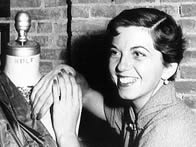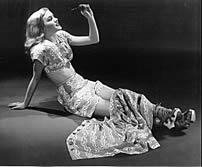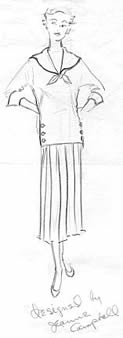Loomtogs, Inc. 1946-1951
"The salary wasn't very high and maybe that's one reason why they thought it was worth while to gamble on me," Jeanne said in an interview with Beryl Williams. Jeanne's clothes were very well received by the buyers, and sales were on the rise. The time at the house of Loomtogs proved to be very demanding and rewarding, working under President Arnold Schoenfeld. Jeanne wore many hats there having to use every technical and creative design ability she knew. With only one sample maker in the big Loomtogs workroom, Jeanne often had to translate her sketches into made-up dress samples, and to work closely with the patternmaker until her original idea was transformed into a product that could be profitably duplicated. She even spent some time talking with the buyers in the showroom. Jeanne was involved in all aspects of the firm to ensure the success of her line.
Another promotion Jeanne was involved with was a Whistler-inspired fashion show. The Guild of New York Dress Designers, a new organization at that time, had an extravagant art-fashion show at the Brooklyn Museum on June 3rd, 1948. Jeanne's layered "apron-effect" in combinations of fabrics, made all the papers. (For more on this and the Brooklyn Museum, go to the Industrial Division/Design Laboratory section.) In an article in the New York Herald Tribune, 11/10/48, Eugenia Sheppard wrote about Jeanne's love of color, her hobby of interior decorating, and a summery line of beach coats, tubular bathing suits, shorts, and slacks of iridescent denims, destined to be best sellers. Ms. Sheppard was right! She also went on to say, "Jeanne's own favorite creation is a wool-backed orange satin hostess coat- proof of her theory that best evening clothes just carry sportswear silhouettes into fancier fabrics. She lined the orange coat with chartreuse and adds high velvet boots that button up the back." Eugenia ended the picture filled article by saying, "After this her big ambition won't surprise you--to be a topflight, big name American designer." Ms. Sheppard was right again.
Jeanne also designed an outfit that was reminiscent of the 1920's flapper era. It was to receive a great deal of popularity and it shook up the press. The revival outfit was simple, but very unlike the fashions of the era, it had a loose waist and proved very popular with the college aged girls. It was a navy wool jersey middy top with a real sailor collar, hip slits (with buttons) which tapered in slightly at the waistline, and a straight, navy serge knife-pleated skirt. Jeanne's updated "flapper" middy outfit appeared in the June 15, 1949 Women's Wear Daily article titled "the Big Nine in College Fashions", and it was also featured in the Aug. issue of Glamour Magazine. More press followed in the fall from The New York Times, Oct. 13, 1949 under the heading,"'Flapper' of 1920's is Back in Style", and the navy outfit appeared again in the Oct. 24th issue of Life Magazine's article, "Does the American Woman Need a New Figure?" In the latter, both a popular trend in a revival short hair style called the "shingle", and Jeanne's outfit, illustrated what seemed to be a fear that fashion trends were bringing back the '20's silhouette and its "bustless, boyish shape". Jeanne had to come up with many diverse summer clothes as this was Loomtogs biggest line, as well as a small late winter cruise line, and fall sportswear. She was versatile, dreaming up playful, active, comfortable, and practical clothes (like pockets- deep enough so you really can use them) that suited her lifestyle as well. She considered herself a model for other women by drawing upon her life's experiences. Jeanne knew what sort of clothes would hold up well and what fabrics were durable too. Early she used denims, patterned and plain. Then striped corduroys were her specialty, and then she favored patchwork quilted skirts, lined with calico, for the holidays. The combination of good looks, fun and practicality would become Jeanne's signature in fashion.
"It was a good time to be getting into sportswear," Jeanne explains, as if half-apologizing for her quick success. "It was the moment when casual sports clothes were beginning to mean more than they ever had before--when they were coming to have some of the importance they have today." An excerpt from Beryl Williams' 1956 book, "Young Faces in Fashion". By the end of 1951, the originality and quality of the designs Ms. Campbell had produced at Loomtogs won her Mademoiselle's Merit Award in Fashion. (Other Loomtogs luminaries include designers: Donald Brooks, John Weitz, and Leo Narducci. See Honors for more info. on the Mademoiselle award.)
|
 Jeanne and her husband, Bud, had settled in New York City after
the war. After some small design jobs (that included designing
luxurious slippers for Gustave Inc.), in 1946, Jeanne's career
was starting to take flight. The prominent post-war designers were
creating a new "American Style" and Jeanne's innovative
ideas would express the look.
Jeanne and her husband, Bud, had settled in New York City after
the war. After some small design jobs (that included designing
luxurious slippers for Gustave Inc.), in 1946, Jeanne's career
was starting to take flight. The prominent post-war designers were
creating a new "American Style" and Jeanne's innovative
ideas would express the look. 
 Loomtogs
devoted a great deal of energy toward promotion, and received a
good deal of press because of it. One promotion, released
June 6, 1947, was to increase sales by marketing a "package" called "Autumn-Mates".
Coordinating separates like shirts, slacks, jackets, culottes,
etc. wasn't a new idea, but they claimed that using colors to be
mated with other colors to "harmoniously blend with each other" was
new. Newspapers and large department stores responded well. Loomtogs
revived their promotional name, "Shufflemates", during
their 1948 resort-line. It was the first post-war season for this
name revival.
Loomtogs
devoted a great deal of energy toward promotion, and received a
good deal of press because of it. One promotion, released
June 6, 1947, was to increase sales by marketing a "package" called "Autumn-Mates".
Coordinating separates like shirts, slacks, jackets, culottes,
etc. wasn't a new idea, but they claimed that using colors to be
mated with other colors to "harmoniously blend with each other" was
new. Newspapers and large department stores responded well. Loomtogs
revived their promotional name, "Shufflemates", during
their 1948 resort-line. It was the first post-war season for this
name revival. Fashion
magazines and newspapers were showing Jeanne's Loomtogs designs
all the time. The New York Times, Glamour, Mademoiselle, Women's
Wear Daily, Life, Vogue, the New York Herald Tribune were a few
that Loomtogs appeared in. Even in a movie magazine- "Modern
Screen", June 1949, showed Ava Gardner modeling Jeanne's striped
corded cotton chambray, halter sun-dress to promote her latest
movie. They said, "Ava, the luscious, whom you're currently
drooling over in MGM's "The Great Sinner", wears a sundress
that rates prolonged whistles...and will do the same for you any
weekend at all.
Fashion
magazines and newspapers were showing Jeanne's Loomtogs designs
all the time. The New York Times, Glamour, Mademoiselle, Women's
Wear Daily, Life, Vogue, the New York Herald Tribune were a few
that Loomtogs appeared in. Even in a movie magazine- "Modern
Screen", June 1949, showed Ava Gardner modeling Jeanne's striped
corded cotton chambray, halter sun-dress to promote her latest
movie. They said, "Ava, the luscious, whom you're currently
drooling over in MGM's "The Great Sinner", wears a sundress
that rates prolonged whistles...and will do the same for you any
weekend at all.

 In a New York Times article, Oct. 1st, 1951, fashion editor, Virginia
Pope interviewed Jeanne. In her "Patterns of The Times: American
Designer Series", under the heading, "Casual and Sports
Togs by Jeanne Campbell Show Young Spirit", Virginia wrote "In
youth lies the future of American designing. Unaffected by European
influences, it offers us an untrammeled expression of young America.
Our designer today exemplifies this spirit."
In a New York Times article, Oct. 1st, 1951, fashion editor, Virginia
Pope interviewed Jeanne. In her "Patterns of The Times: American
Designer Series", under the heading, "Casual and Sports
Togs by Jeanne Campbell Show Young Spirit", Virginia wrote "In
youth lies the future of American designing. Unaffected by European
influences, it offers us an untrammeled expression of young America.
Our designer today exemplifies this spirit."